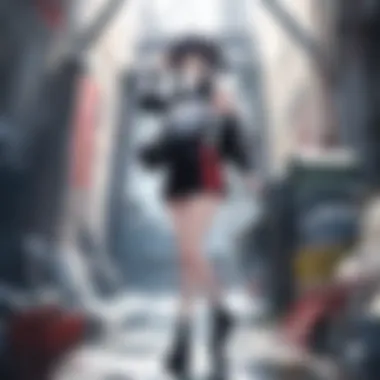Entering the Zone: Immersive Anime and Manga Experience


Intro
The world of anime and manga is not just a source of entertainment; it is a cultural phenomenon that provides fans with a unique avenue for deep emotional and psychological engagement. This article sheds light on how fans connect with their favorite series, drawing them into a realm that transcends mere observation. By exploring the factors that facilitate this immersive experience, we can appreciate storytelling and character development in a new light.
Series Overview
Synopsis and Premise
Anime and manga often present intricate plots that delve into the human condition, societal issues, or fantastical worlds. Each series offers a distinct narrative style that captivates viewers and readers alike. Not only do these stories entertain, but they also resonate on various levels. Themes of friendship, love, and struggle are common, creating a foundation for emotional investment.
Notable Characters
Characters serve as bridges between the story and the audience's emotions. Well-developed characters have depth and complexity that make them relatable. From the ambitious Naruto Uzumaki to the enigmatic Shinji Ikari from "Neon Genesis Evangelion", these characters' journeys allow fans to reflect on their own experiences. The richness in character development amplifies the immersion that fans feel when engaging with these series.
Themes and Motifs
Major Themes Explored
Many anime and manga series explore universal themes such as identity, morality, and the concept of belonging. These profound themes invite viewers to reflect on their own lives. For instance, series like "Attack on Titan" examine freedom and oppression, prompting discussions that extend beyond the fictional world.
Symbolism in Storytelling
Symbolism plays a critical role in enhancing the narrative. Objects, colors, or recurrent motifs can signify deeper meanings. For example, the use of cherry blossoms in "Your Lie in April" symbolizes beauty and the fleeting nature of life, leaving viewers in a state of contemplation. Such elements contribute significantly to the engaging nature of these narratives.
Artistic Style and Animation
Visual Aesthetics and Design
The visual aspects of anime and manga are integral to its appeal. Unique art styles can evoke different emotions and enhance storytelling. Each artist brings their personal touch, creating visual landscapes that viewers often identify with. The intricate designs and vibrant colors create a vivid experience.
Animation Techniques and Trends
Techniques such as 2D animation have evolved significantly over the years. Monogatari Series and Demon Slayer are notable examples that showcase high-quality production values. The evolution of technology continues to shape how stories are told through visual mediums, allowing for a more immersive experience.
"Immersion in anime and manga is not just about watching or reading; it's about forming connections with the characters and the world they inhabit."
The Concept of Entering the Zone
The concept of entering the zone is crucial to understanding the anime and manga culture. This phenomenon describes a deep immersion where fans experience a profound emotional connection to the characters and stories. It is not solely about entertainment; it signifies a state where viewers or readers engage cognitively and affectively, leading to lasting appreciation and attachment.
Immersion allows fans to escape into worlds crafted with intricate detail. The blending of storytelling and artistry creates not just passive consumption but active engagement. Fans find themselves part of narratives, investing time and emotions closely. This leads to a heightened state of enjoyment and connection which can be transformative.
Understanding the zone can bring insights into how creators and marketers shape the anime and manga industry. Creators employ various techniques to pull audiences into their narratives. Attention to character development, plot complexity, and visual aesthetics all play significant roles. This comprehension can benefit both fans wishing to deepen their understanding and creators aiming to connect better with their audience.
Understanding the Zone Phenomenon
The zone phenomenon represents a particular state where fans lose track of their surroundings while consuming anime or manga. This psychological state is characterized by deep focus. Fans often report feeling time slip away, highlighting the powerful draw of the content.
In this zone, various sensory inputs converge. The visual element of animation or manga illustrations engages sight, while dialogues and soundtracks add layers to the experience. This multisensory engagement amplifies immersion. Fans feel emotions that characters convey through their stories, often identifying with their struggles and triumphs.


Moreover, the scope of themes in anime and manga broadens typical storytelling. From fantasy worlds to everyday scenarios, the ability to traverse different realities makes it easier for fans to find relatable content. Consequently, entering the zone has the potential to enhance empathy as viewers relate intimately with others’ experiences.
Psychological Implications of Immersion
Immersion in anime and manga carries several psychological implications. When fans enter this state, they often process themes on a personal level. Emotional responses can mirror real-life situations, assisting in coping mechanisms. Enjoying narratives that reflect struggles or celebrations can be therapeutic by offering insights or comfort.
Some studies also suggest a link between immersion and cognitive development. Engaging with complex narratives enhances problem-solving skills and critical thinking. Fans analyze characters' motivations and plot developments, training their minds to think critically.
However, there can be downsides to this immersion. Excessive engagement might lead to escapism, where reality becomes burdensome compared to the allure of fictional worlds. It's vital for fans to find balance.
"Entering the zone means letting anime and manga transcend mere storytelling; it becomes a shared experience that comments on life itself."
Overall, the concept of entering the zone represents an intricate dance between emotional impact and cognitive engagement in anime and manga. Understanding it can greatly enrich one’s appreciation and interaction with this beloved medium.
Cultural Context of Anime and Manga
The cultural context of anime and manga is integral to understanding their impact and significance in both Japanese society and the global landscape. These art forms are not just entertainment; they reflect and challenge societal values, beliefs, and norms. They bring forth elements of traditional Japanese culture while simultaneously embracing modern themes that resonate with a diverse audience.
The importance of this context is seen in how anime and manga serve as more than mere storytelling vehicles. They encapsulate historical narratives, social issues, and the evolution of artistic styles, providing a compelling lens through which to view Japanese culture and its adaptation over time.
In addition, exploring the cultural nuances within anime and manga enables fans to develop a more profound appreciation of the material. Recognizing historical influences, character archetypes, and thematic trends enhances the viewer's or reader's experience, fostering a deeper emotional connection to the story.
Historical Evolution of Japanese Media
Anime and manga have deep roots in Japan, tracing back to ancient forms of storytelling and visual art. Initially, ukiyo-e paintings during the Edo period introduced the public to narratives through images. As societies evolved, so too did techniques and creative expressions.
In the 20th century, following World War II, manga began to flourish as a popular medium. Artists like Osamu Tezuka, often regarded as the "God of Manga," paved the way with works such as "Astro Boy." This period marked a turning point where anime started to emerge as a form of animation influenced by cinematic techniques, thus establishing its own unique identity.
The subsequent decades saw innovations in production, style, and storytelling. Genres diversified, allowing for niche markets to develop, such as shonen, shojo, and seinen. Each genre brought with it distinct characteristics that appealed to various demographics. For instance, shonen often features action and adventure, appealing predominantly to young male audiences, while shojo focuses on relationships, attracting young females. All these advancements shifted perceptions and made anime and manga accessible to a wider audience, both domestically and internationally.
Modern Trends in Storytelling Techniques
Today, anime and manga storytelling have evolved with remarkable complexity and depth. Creators are experimenting with narratives that reflect broader global themes such as identity, existentialism, and technology's impact on society. This evolution leads to multifaceted characters who grapple with real-life dilemmas, making them relatable to a modern audience.
In addition, the use of transmedia storytelling has expanded, where narratives stretch across animations, comics, and video games, creating a cohesive world that engages fans on multiple levels.
Moreover, the advent of streaming platforms has opened avenues for series that might not have been produced under traditional frameworks. This phenomenon allows for diverse genres to thrive, highlighting underrepresented voices and stories. As the consumer base broadens, the rule of storytelling becomes less rigid, revealing a richer tapestry of narratives.
"The evolution of anime and manga is a continuous dance between tradition and innovation, offering fresh perspectives while honoring the past."
Elements That Facilitate Immersion
Immersion in anime and manga does not occur in a vacuum. Several key elements play a crucial role in drawing viewers and readers deeply into these narratives. Understanding these elements is essential for both fans and creators, as they highlight the factors that enable a powerful connection between the audience and the story. This section addresses character development and relatability, world-building and setting, as well as narrative structures that engage. Each element contributes uniquely to the immersive experience.
Character Development and Relatability
Character development is at the heart of any compelling narrative. In anime and manga, well-crafted characters can evoke strong emotional responses. When characters grow, experience challenges, and engage in relationships, the audience feels invested. Viewers may see parts of themselves in these characters or recognize their struggles, making them relatable. The depth of a character's backstory adds layers, prompting audiences to care about their journeys.
For instance, in series like Attack on Titan and My Hero Academia, viewers connect with the protagonists because they show vulnerability, ambition, and flaws. This complexity allows fans to form emotional attachments, facilitating a sense of immersion. In contrast, characters lacking development often fail to resonate, leading to disengagement.
"A character who is real and complex can change the way viewers or readers perceive their own reality."


World-Building and Setting
World-building constitutes another significant element in fostering immersion. The settings within anime and manga often serve not just as backdrops but as characters themselves. A well-constructed world filled with intricate details captures the imagination. For example, the fantastical realms in One Piece or Spirited Away create a sense of wonder and adventure. The laws of nature, social structures, and cultural elements within these worlds should feel cohesive and lived-in, allowing audiences to lose themselves.
Moreover, the aesthetic choices—visual styles, color palettes, and design elements—further enhance the viewer's experience. These factors shape how the story is perceived, influencing emotions and engagement levels. When a setting invites curiosity and exploration, it intensifies immersion for the audience.
Narrative Structures That Engage
Finally, narrative structures determine how a story unfolds, impacting audience engagement. Different types of storytelling techniques—such as nonlinear narratives, multiple perspectives, or episodic arcs—can create layers of complexity. In many anime series, such as Steins;Gate or The Promised Neverland, the narrative structure is crucial for maintaining suspense and emotional depth.
Engaging storytelling often incorporates cliffhangers or plot twists, prompting viewers to reflect and theorize between episodes. This active involvement ensures that the audience stays connected to the narrative, enhancing their overall experience.
Ultimately, these elements work in concert to create a bridge between the audience and the immersive world of anime and manga. The interplay of character development, world-building, and narrative structures invites deep emotional investment, allowing fans to truly enter the zone.
The Role of Fandom in Enhancing Experience
Fandom plays a significant role in the immersive experience of anime and manga. It offers a platform where individuals connect over shared interests, creating communities that extend beyond mere consumption of media. These interactions vary from discussions about plot twists to sharing fan art or fan fiction. Such activities not only deepen the individual’s appreciation of the material but also strengthen the collective experience.
The sense of belonging in these communities fosters a unique relationship with the content. Fans are not isolated observers; instead, they actively participate in a living, breathing ecosystem of creativity and expression. The act of sharing opinions and engaging in debates about character motivations or story arcs can lead to a deeper understanding. In essence, fandom surrounding anime and manga becomes a conduit for exploring complex themes, emotional conflicts, and character arc developments.
Moreover, fandom creates opportunities for learning. Fans often share their interpretations of narratives through various platforms, leading to enriched dialogues. This exchange can enhance one's critical thinking skills, as fans assess different viewpoints. Fandom thus acts as a catalyst for intellectual growth and emotional exploration.
Community as a Source of Connection
Communities formed in the fandom realm serve as vital networks for individuals seeking connection. Many fans encounter others who empathize with their experiences or feelings regarding specific series.
These connections can take place in various forms:
- Conventions: Events such as Anime Expo allow fans to immerse themselves in a shared environment, filled with activities, panels, and workshops.
- Online Platforms: Websites like Reddit or forums enable fans to discuss theories and favorite moments, fostering a sense of community regardless of geographical location.
- Social Media: Platforms like Facebook and Twitter let fans share their thoughts in real-time, creating an ever-evolving dialogue around new releases or nostalgic classics.
Establishing connections through fandom can lead to strong friendships and partnerships. Many fans build relationships that last long after the anime or manga has concluded. These bonds are often cemented through collaborative projects like doujinshi (fan-made comics) or group cosplays, which emphasize the creativity within the community.
Shared Activities and Their Impact
Shared activities enrich the experience of fandom, allowing fans to bond over common interests. Several forms of shared activities include:
- Fan Art: Creating and sharing art based on beloved characters reinforces one's attachment to the series while also celebrating creativity.
- Fan Fiction: Writing stories set in the universes of favorite shows or manga provides fans with a chance to explore alternative narratives or character developments.
- Cosplay: Dressing up as characters serves as a physical manifestation of fandom, providing a sense of community during conventions or online showcases.
These activities encourage collaboration, as fans often come together to exchange ideas, tips, and feedback. They also enable personal expression, allowing fans to demonstrate their commitment to their favorite series. This engagement often leads to enhanced connections with both the material and fellow fans, creating an enriching cycle.
The dynamic nature of fandom ultimately makes these shared activities more than just leisure pursuits; they become integral to understanding the emotional and cultural significance of anime and manga.
"Fandom is not only about consuming, but also about creating and connecting with others. It opens new dimensions to otherwise linear narratives."
Impact of Online Platforms on Engagement
Online platforms play a crucial role in shaping how fans interact with anime and manga. As a result of the digital age, many fans now engage in the immersive world of their favorite series in ways that were not possible before. This section will explore the specific elements that have been impacted by online platforms, including social media dynamics and the influence of streaming services. Both of these elements have created new avenues for engagement and have redefined how fans consume and connect with content.
Social Media Dynamics and Fan Interaction


Social media has revolutionized the way fans communicate and interact with their favorite anime and manga. Platforms such as Twitter, Facebook, and Reddit provide spaces where fans can express opinions, share artwork, and participate in discussions about plot developments and character arcs. The immediacy of social media allows fans to engage in real-time conversations about episodes as they air or chapters as they are published.
From fan art to memes, the creativity of the community thrives on these platforms. Fans often use these mediums to discuss their feelings more deeply about certain storylines or characters. This leads to a shared cultural context that enriches the understanding of the series as a whole.
"Social media has made it possible for anime and manga fans to connect globally, forging friendships and communities around shared interests."
Moreover, the dynamics of fan interactions have shifted. Rather than isolating themselves with their favorite series, fans are now part of a global conversation. This can create a sense of belonging and support as they find others who resonate with their passions. Additionally, creators often utilize platforms to engage directly with fans, gathering real-time feedback or teasing future content. This direct connection enhances the immersive experience.
Streaming Services and Accessibility
The rise of streaming services like Crunchyroll, Funimation, and Netflix has transformed the accessibility of anime and manga. These platforms have made it easier than ever for fans to access a wide variety of series and films from the comfort of their homes. It has expanded the reach of anime and manga, introducing new audiences who may not have previously explored this medium.
Streaming services not only provide a vast library of content but also offer features that encourage binge-watching and continuous engagement. Many platforms release episodes on a seasonal basis, allowing fans to follow along with their peers and discuss episodes weekly. The accessibility of subbed and dubbed versions makes the content approachable for a broader audience, including those who may not be fluent in Japanese.
Furthermore, the user interface of these platforms often includes recommendations based on viewing history. This algorithm-driven approach helps fans discover series that align with their tastes, fostering an environment where diving deeper into the genre becomes natural. This accessibility can lead to increased discussions and community building as fans share recommendations and personal reviews.
Case Studies of Immersive Series
Understanding case studies of immersive series is essential for grasping how anime and manga captivate their audiences. This section illustrates specific examples that exemplify the strategies and techniques creators use to engage viewers. These case studies provide insights into narrative structure, character development, and the overall presentation of themes. By examining the dynamics of notable series, readers can appreciate the depth of immersion that keeps fans returning.
Analysis of Iconic Works
Iconic works serve as benchmarks for what successful anime and manga can achieve in terms of immersion. For instance, series like Neon Genesis Evangelion and Attack on Titan offer rich narratives paired with complex characters. Both series challenge viewers’ expectations and delve into themes of identity, trauma, and societal conflict. The writing and visuals push boundaries, creating a profound emotional experience.
- Neon Genesis Evangelion presents profound philosophical questions alongside its action-packed narrative. The psychological depth of its characters resonates. Fans often forge personal connections with these struggles. This connection enhances immersion, allowing viewers to engage not just with the story but with their own feelings.
- Attack on Titan, on the other hand, employs tension and suspense. The pacing of the storytelling captivates audiences right from the start. Each episode builds anticipation and urges audience engagement. The world-building in this series shapes a universe that feels real and perilous, drawing viewers deeper into the conflict.
These examples highlight that successful anime and manga do more than entertain. They create layers of meaning that resonate with fans on multiple levels, ensuring that once viewers enter the zone, they find it hard to exit.
Emerging Series Worth Exploring
In addition to well-established icons, emerging series also deserve attention. They may not yet have achieved wide recognition, but they are making strides in creating immersive experiences.
For example, Chainsaw Man has quickly garnered a strong following. Its unique blend of action and dark humor sets it apart. The character development is refreshingly honest and raw. This allows fans to connect emotionally to the protagonists’ struggles and motivations.
Another example is Demon Slayer: Kimetsu no Yaiba. The animation quality is exceptional, engaging viewers through its vibrant visuals. The storyline taps into themes of family and perseverance. Audiences resonate with main character Tanjiro Kamado’s journey, which fosters a connection that enhances viewer immersion.
Alongside these examples, series like Jujutsu Kaisen also merit exploration. Combining intense action with supernatural elements, it successfully marries fun and depth. The friendship and rivalry among characters create emotional stakes that draw viewers into the narrative.
These emerging series contribute to the rich tapestry of anime and manga. They explore new themes and ideas, ensuring that the world remain vibrant and engaging. Fans have the opportunity to discover fresh stories, allowing them to dive deeper into the immersive experience.
Closure: The Enduring Appeal of Anime and Manga
The appeal of anime and manga goes beyond mere entertainment. It embodies a rich tapestry of storytelling, character development, and communal engagement. These forms of media have adapted over decades, resonating with diverse audiences worldwide. Such adaptability ensures their relevance across different cultures and generations. Fans not only consume content but engage in a holistic experience marked by emotions and connections.
Reflections on Long-Lasting Engagement
The long-lasting engagement with anime and manga can be attributed to several factors. First, the characters resonate deeply with viewers. Audiences often find themselves emotionally invested in their journeys. This creates a strong bond, fostering loyalty among fans that can last years or even decades.
Moreover, the multifaceted narratives allow for layers of interpretation. Anime and manga often address complex themes such as identity, loss, and personal growth. Such themes speak to the human experience, drawing in viewers seeking meaningful stories. The ability to encounter different perspectives enriches the viewer's understanding, thus enhancing the engagement.
Additionally, the community aspect cannot be overlooked. Fandom creates a sense of belonging. Fans unite to discuss plotlines or character arcs, which deepens their appreciation. Online platforms and social media have amplified this phenomenon, connecting millions across the globe. It facilitates the exchange of ideas and theories, enriching the overall experience of anime and manga.
Future Directions for Fans and Creators
Looking forward, both fans and creators have unique opportunities to shape the future of anime and manga. As technology evolves, so do the mediums through which stories are told. For fans, exploring new forms of content such as virtual reality can provide even more immersive experiences. Engaging with creators through platforms like Kickstarter can allow fans to support projects they believe in directly.
For creators, the challenge lies in balancing originality with the expectations set by established franchises. There is potential for innovation through merging various genres or experimenting with storytelling techniques. By providing fresh narratives or diverse representation, they can capture a wider audience.

